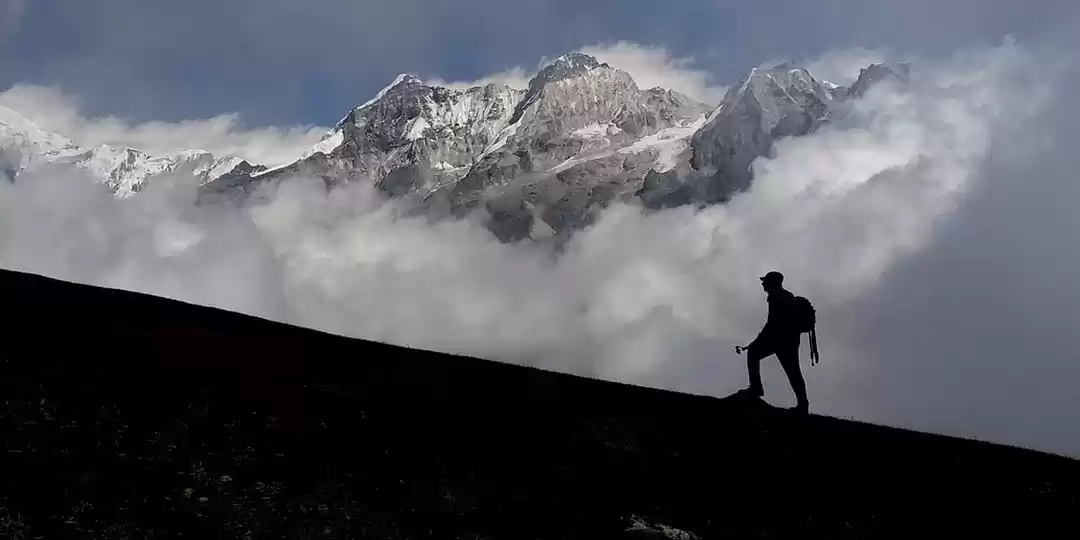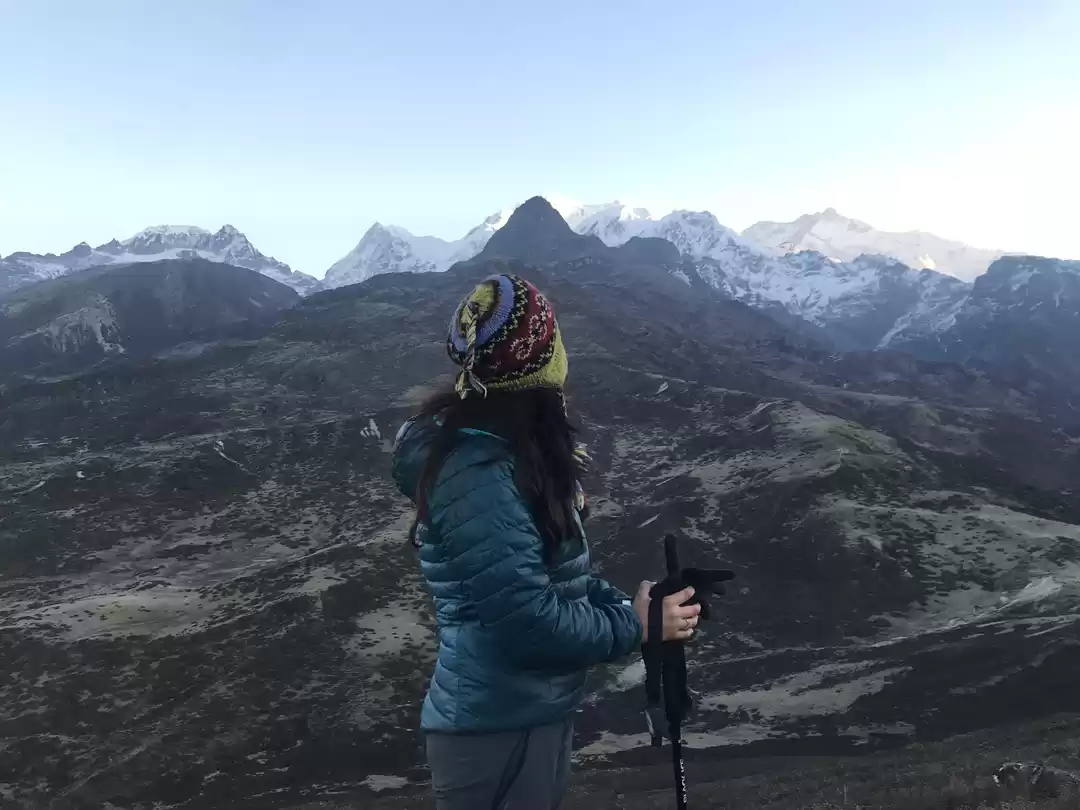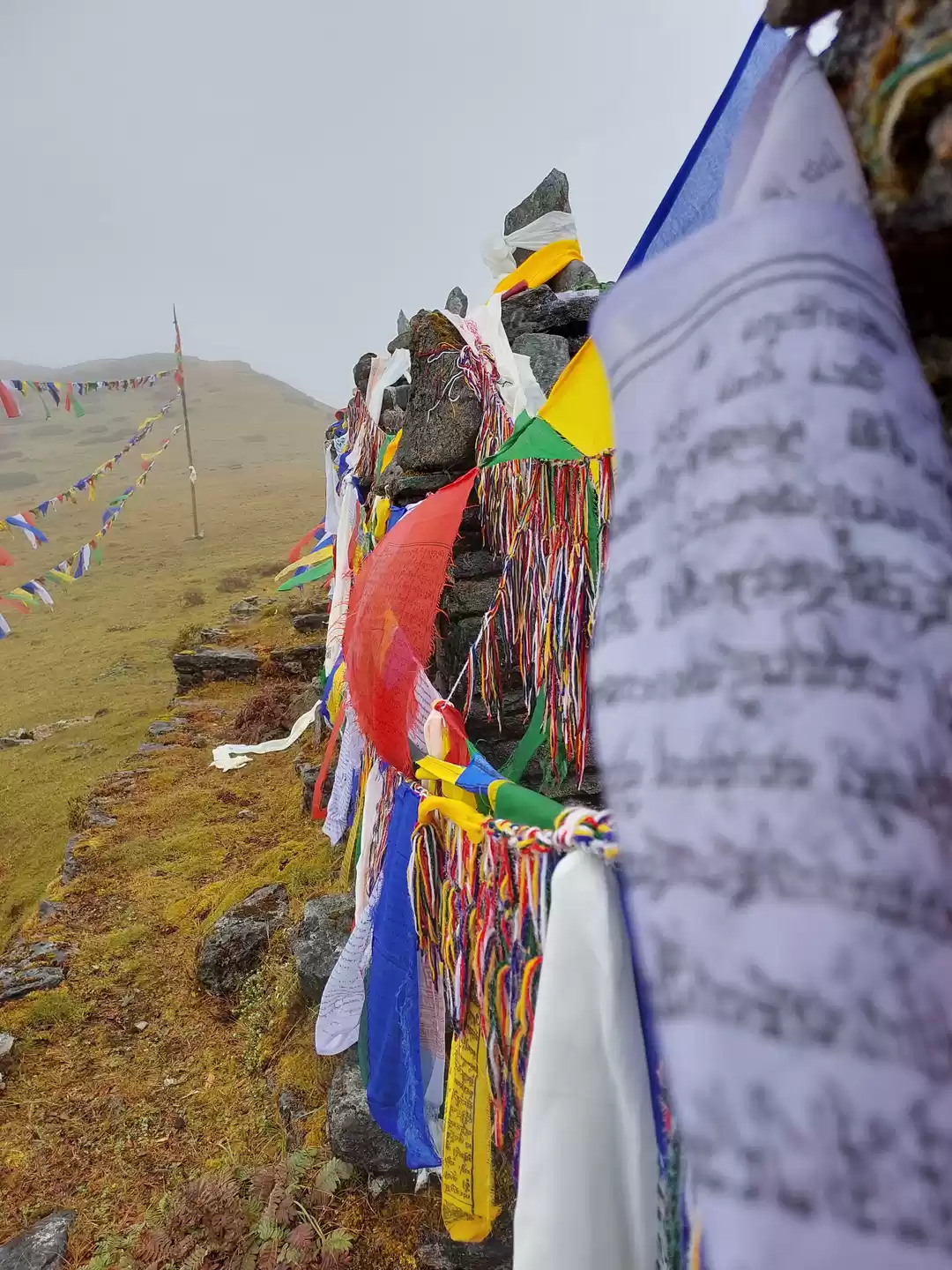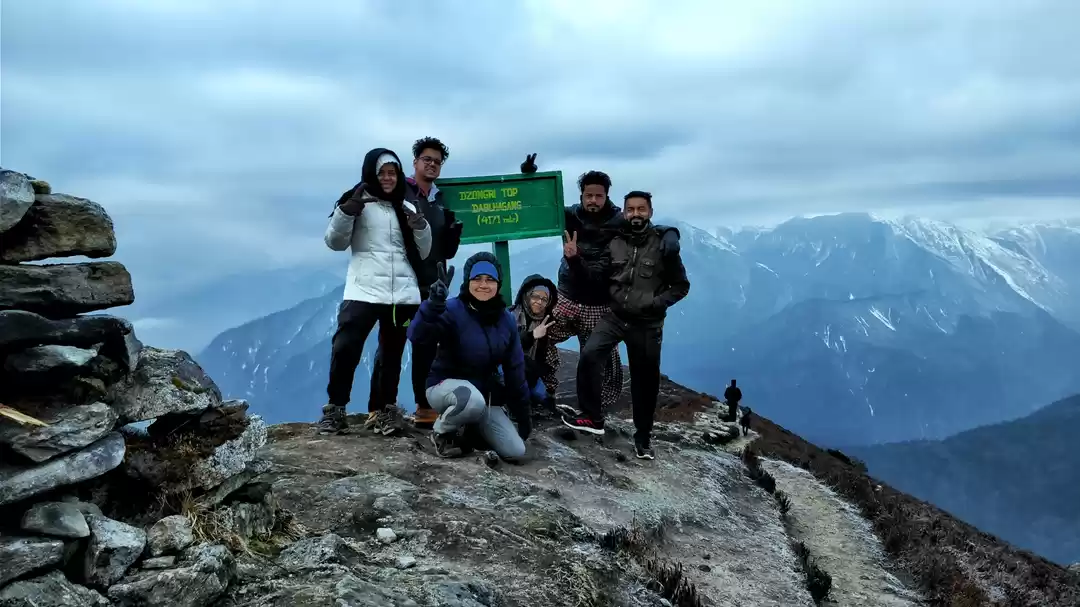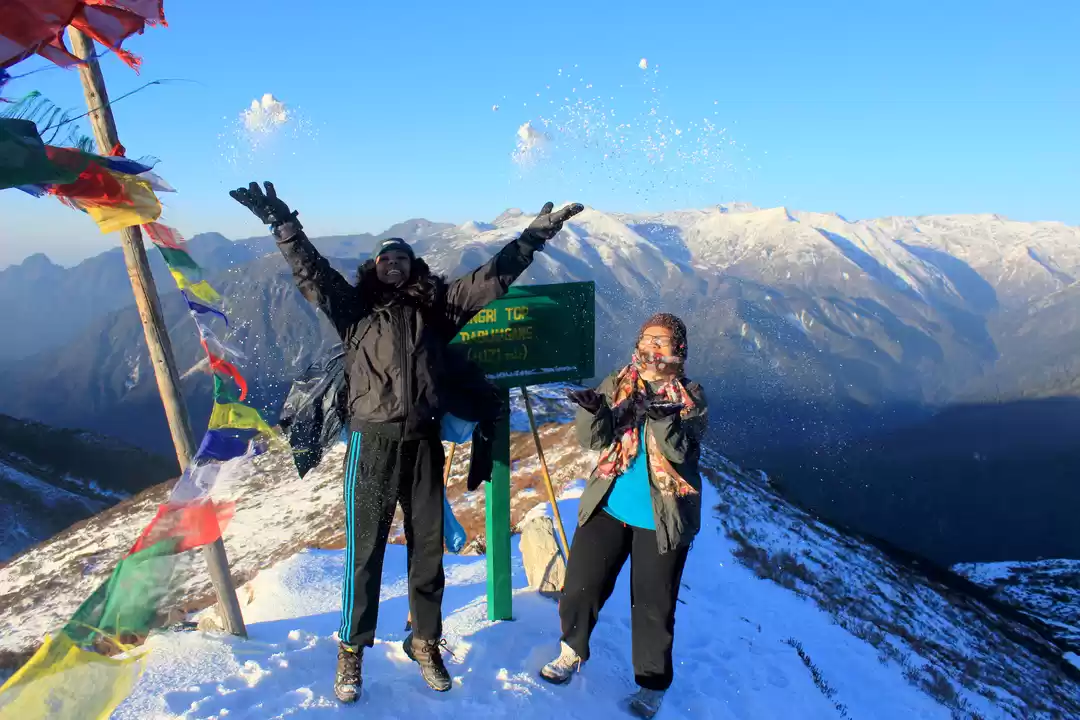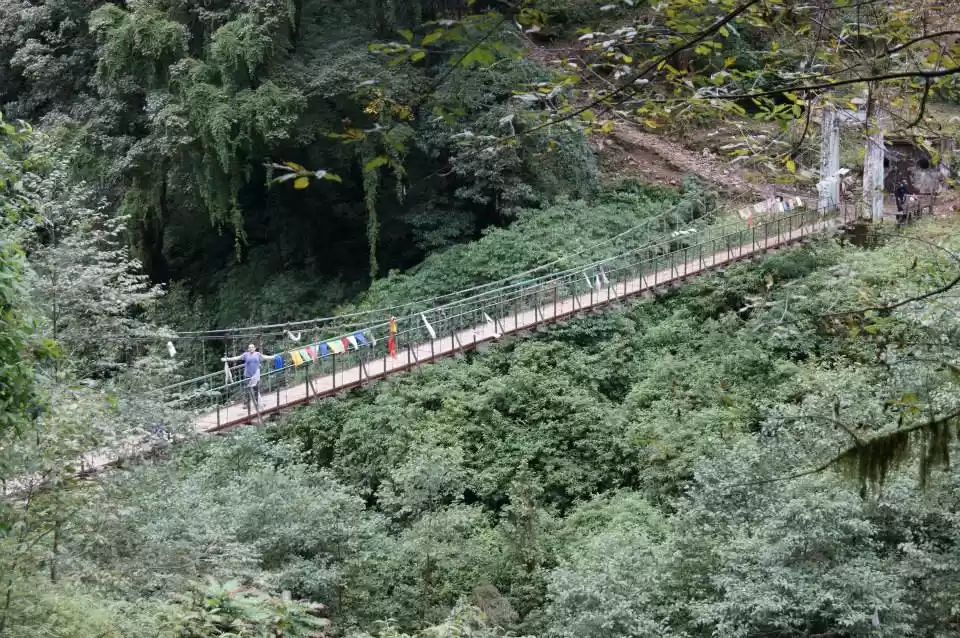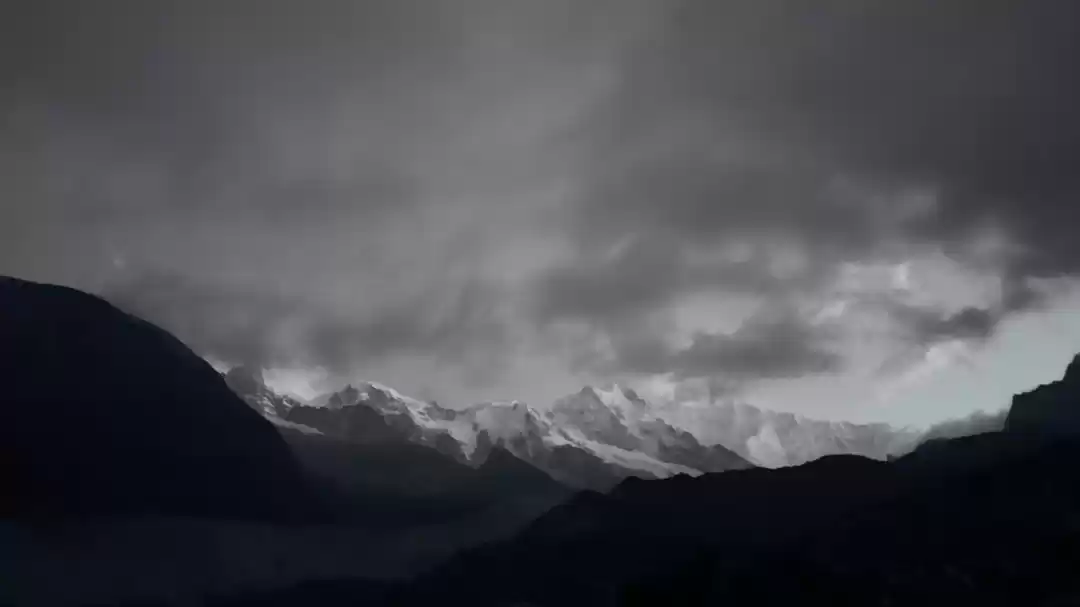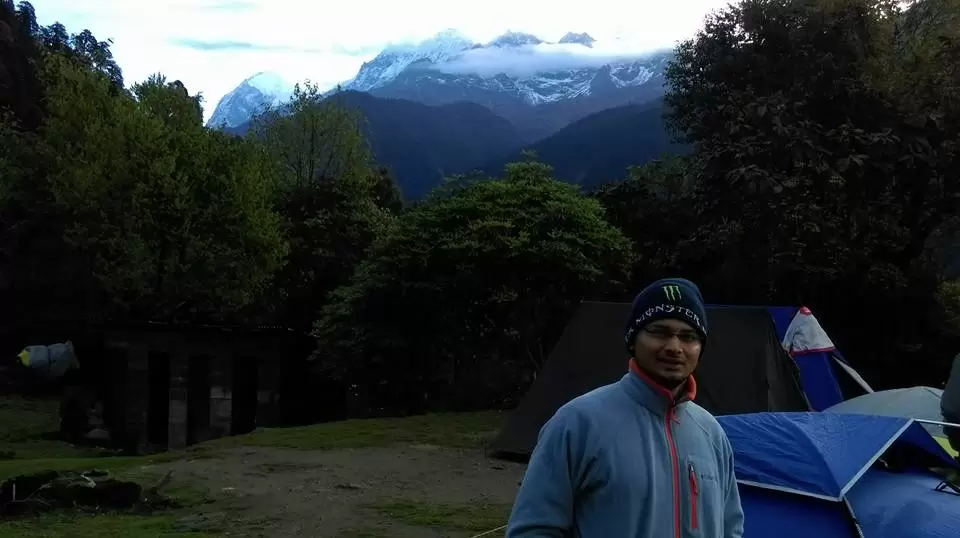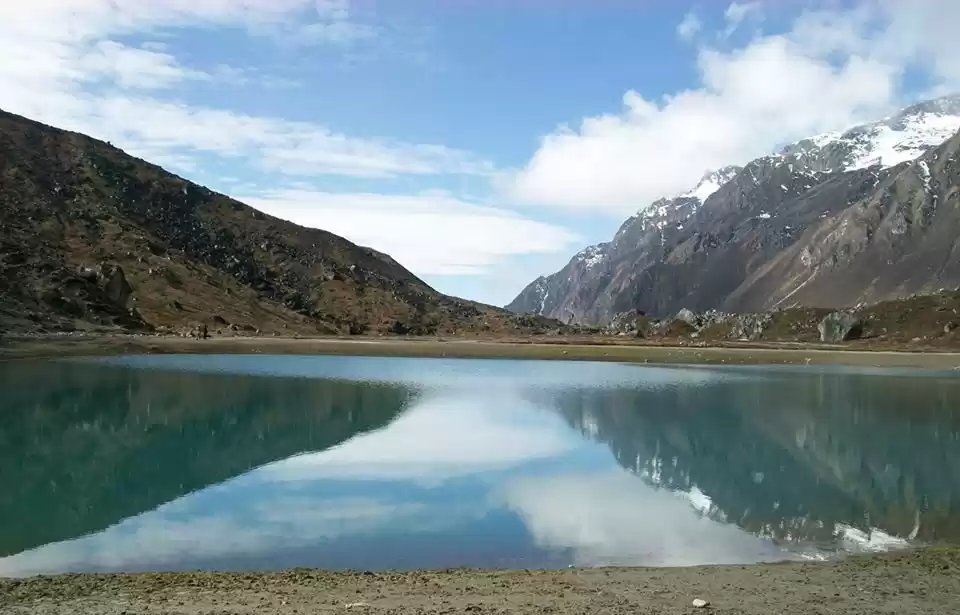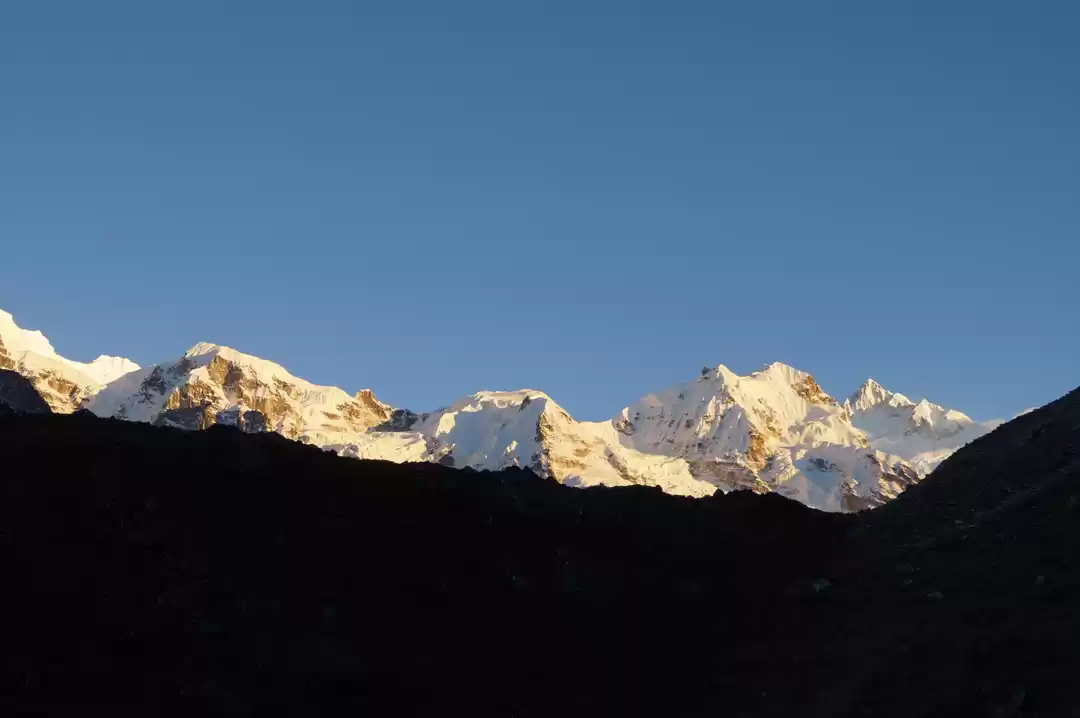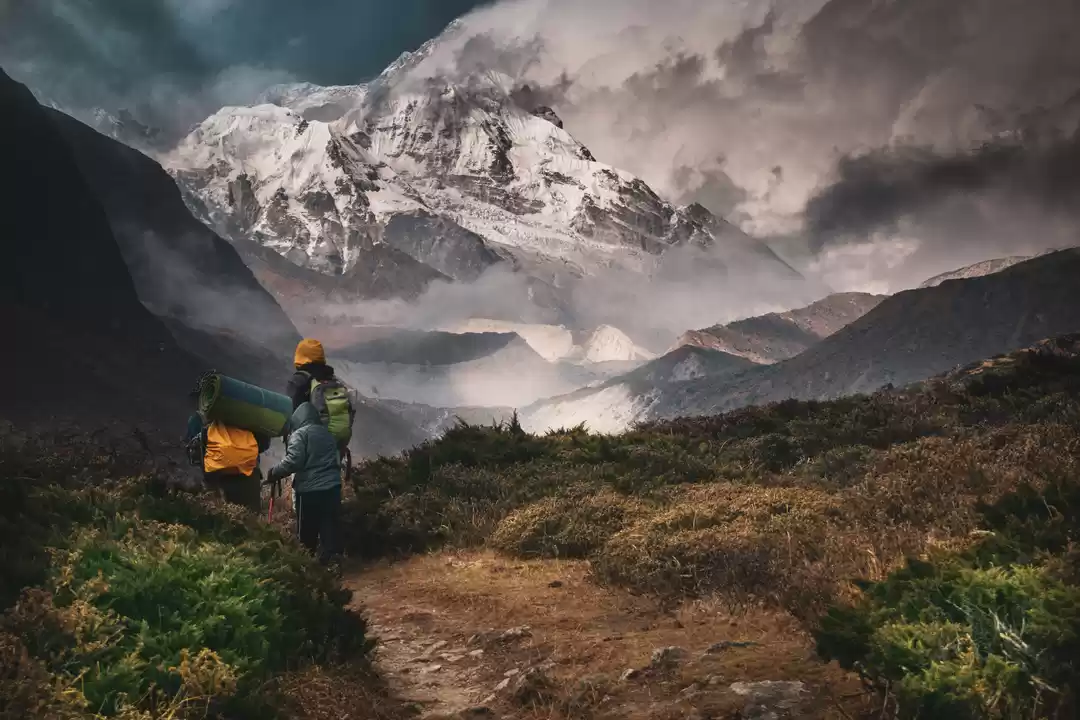
Located in the Kanchenjungha National Park in Sikkim, Goecha La is a well known trek among trekking enthusiasts in India as well as abroad. Within its 95 kilometers span this trek goes from 5,000 to 15,000 feet approximately and offers everything from dense, throbbing forests filled with beautiful rivers and waterfalls to divine high altitude meadows, glacial lakes and eventually, if the weather permits, majestic displays of Kanchenjungha along with Pandim and other mighty Himalayan peaks.
The Goecha La trek had been in my bucket list for some time, but it eventually it materialized in late October- early November last year - arguably the best time to do the trek. The weather generally stays clear during this time and allows for relative ease in trekking as well as astounding views of the snow-capped mountains. It did stay perfect last year as well and I enjoyed the best weather in my trekking experience till date. Following is a day-by-day account of this spectacular trek. Kindly note that the altitudes here are approximate - with possible variations of 50 meters and the "time taken" is time taken by me with a sack weighing about 10 kilograms. Do not go by it, as the time taken by different individuals vary wildly and it is never a yardstick to judge anybody in the mountains.
Day 1 : Through enchanting forests. Yuksum to Sachen to Bakhim
Altitude covered: 5,500 - 8,500 feet
Time taken: 7.30 hours

The trek starts from Yuksum, a small, sleepy Himalayan town that is a tapestry of two strangely different eras and auras. In a distant past, it was the adobe of kings and monasteries, the remains of which still remain. In more modern times it has emerged as one of the biggest trekker's hubs in north -east India - a place full of scattered homestays and food joints especially famous for yummy momos.
On a sunny, crystal clear late October morning we started our trek from the vast, bowl shaped valley of Yuksum. It started with a short trail up which quickly evened out. Soon it became typical of any Himalayan forest trails. Deep, dense forests clung to the trail from both sides. Immense gorges, wild waterfalls and deep streams threaded through the forest greens. The deep, throbbing greenery surrounded me and their canopy prevented the sunlight from entering the trail. The shadows, breached just ever so slightly by the incoming streaks of light, created a different world of shades. The sounds of the forest became more and more prominent. Through all of that I settled into my own rhythm and with that a sense of oneness with the surroundings developed, almost imperceptibly.

Occasionally teams of yaks and horses, guided expertly by the mountain people passed by me. The sounds of their hoofs and clinging bells lingered on for a while before disappearing into the forest again.
It continued like this through the throbbing forest of lilting lights, shades and shadows. The undulating trail would wind up and down till a certain point from where it suddenly rolled down to the base of the hill where I crossed an old hanging bridge over a gushing stream and entered into even denser forests.

With each step, the forest started to become deeper, denser and more silent. The magnificent forest, the wild waterfall, the sounds of leaves just floating around from higher branches and coming to rest on the forest bed - it was just another world altogether.

After continuing along the undulating forest trail for a few more hours, at around mid day, I arrived at Sachen, the first designated camp site. We were not to stop there for the day; it was to be just a lunch break to refresh ourselves. After a refreshing lunch that we had packed at Yuksum and some chatter with a few trekkers from other groups, I resumed the trek again.

The initial bit was a bit steep and then it suddenly rolled down towards the base of the forested hill. There was another waterfall, bigger and mightier and another hanging bridge across it. The rusty bridge swayed with every step even as the waterfall rushed by below. After crossing this bridge, there was a huge rock and then a decidedly steep trail.

It was just about 2 PM. As I sat there, the Buddhist prayer flags across the bridge fluttered in the wind, the waterfall roared on and the cricket-filled forest started to come alive.
The trail immediately became steeper than anything that we had crossed till then. With that the forest also became denser. In stretches like that in a trek you just focus on a few yards ahead of you, set your own pace and move on at that pace only. However slow or painstaking it is, you don’t stop.
The tall trees canopied the sky to such extent that at the forest floor darkness had already started to swoop in. The dense forest now throbbed with a silence that only happens in Himalayan forests. A silence that nestles in the tree trunks, the densely clustered foliage, the moss on the trunks and from there, it starts to claw into the trail itself.
I crossed that leg silently and slowly. The slope became slightly easier after a while and about an hour later I reached Bakhim, a precariously hanging place with a couple of huts and a small opening in front of that. That is where we would camp for the night.
When I reached there, it was barely around 4.30. Only a couple of other trekkers had reached by then. We clustered together within a small, circular wooden enclosure. The clouds were setting in the layers of mountains just ahead and it was already getting uncomfortably cold.
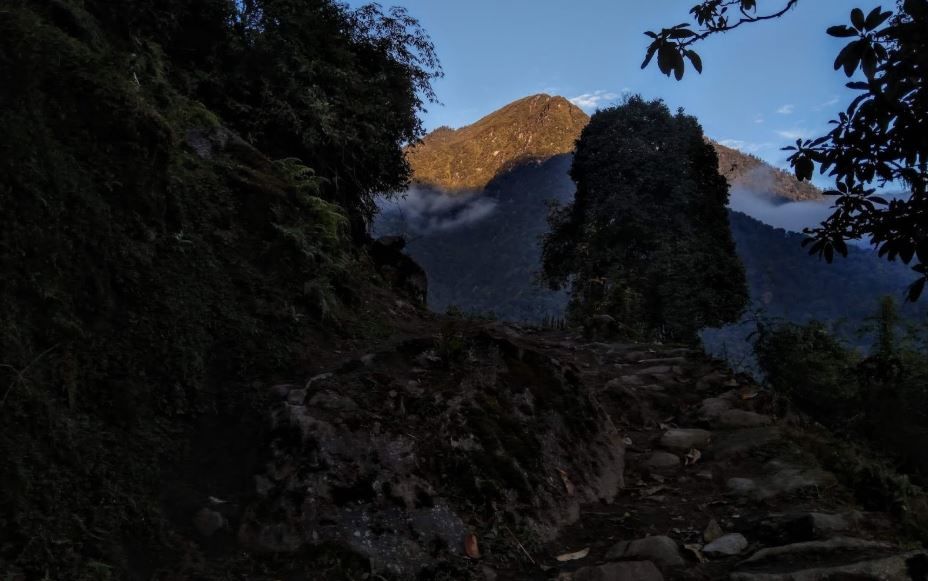
A hot tea was followed by some refreshing snacks from the nearby stone hut and about an hour later a few others of the team joined. A few more were still in the forest.
Gradually, all of them arrived - some in decent shape, some barely trudging along. As we huddled inside the wooden enclosure, someone started to hum a tune. In the stone hut beside, dinner was being prepared.
Above us, a billion stars dazzled along. The milky way spread over and beyond the Himalayan sky and a seriously cold mount night settled in.
After an early dinner, we went inside the tents and slid under the sleeping bags for the night. It was a relatively long day’s trek. Next day would be a relatively shorter hike.
But all steep uphill and we would be gaining quite a bit of altitude.
Day 2: Towards elevated realms. From Bakhim to Phedang
Altitude covered: 8,500 - 13,000 feet
Time taken: 4.30 hours

The next day started with clear skies and the entire scene was splashed by an exquisite brightness. With that, one of the first things that became visible was a dilapidated two-storied house with yawning cracks on its walls just about 50 meters away from where we had pitched the tent for the night. The house was barely visible the evening before for a brief while before being quickly gobbled up by the incoming clouds.
“Haunted house.” Mr. Limbu, our trek guide, said in a totally matter-of-fact manner. Apparently, it used to be the Bakhim forest bungalow long back before an earthquake rendered it inhabitable. Our trail took us past that house soon enough and with its broken glass-panes, yawning cracks and the words "ghost" and "ghost house" scribbled on it prominently, you would probably not like to dispute that claim!
Past the house, the trail swirled up in steep switchbacks. There were a number of trekkers coming down from Tshoka, the next camping site. If you had any erstwhile trekking experience, you could gauge from their speed that this would be quite a tough trudge up.
It indeed required quite a bit of constant uphill trek until the trail evened out a bit and we reached Tshoka.
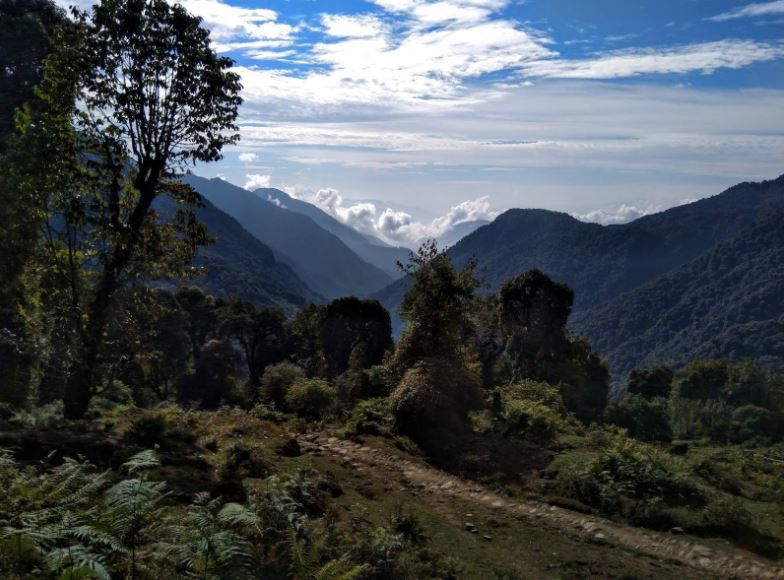
With its monastery; a beautiful lake which on a clear day reflects the snowy mountains on the north; its prayer flags, a couple of old chortens, a beautiful pasture land and a few huts and shops - Tshoka is a place that almost falls off the pages of a fairy tale. I took a breather here; taking a few bites from the packed breakfast of boiled eggs and potatoes, seeped in some water and then started moving along again.
The trail circumnavigated the lake and right after the lake was crossed, it instantly became steep. I let a few yaks and horses pass by so that I could have the trail to myself.

Soon enough the trail became exhausting with its steep turns and bends. The forest, however, also started to become superlatively beautiful with that. The altitude was much higher now and so the mighty pines started to get mingled with sprouts of rhododendrons.

The famous wooden trail of the Goecha La trek also started from hereon. Made of wooden logs, this trail winded up through the forest. Nested by the beautiful shade and scenery all around, it made for some enchanting visuals that would stay etched in a soft nook of memory for a very long time.

Looking up, I could see the magnificent spreads of color that canopied the sky and occasionally, created strangely beautiful frames. That spectacular beauty did lessen the travails of the trail considerably, but still it was exhaustively uphill for quite a long stretch before it sort of evened out a bit and with that the wooden trail gave away to a stony trail. A row of Buddhist prayer flags hang across a beautiful, natural entrance within the forest and there was a slightly wide, circular opening in the middle of the forest.

The trail now became even steeper and boulder strewn. As the journey became tougher, strange shapes and forms started appearing through the foliage and tree trunks at every other turn. However, by now, exhaustion had bogged me down enough to just watch and wonder. The shapes were everywhere – strange beasts, mythical creatures, unearthly figurines – all seemed to metamorphose out of the moss laden branches, the stones, the shadows and the lights threading through them…
However, by that time I was so drained out that I didn't even have the energy to pull out my smartphone and compose an image.

After some more huffing and puffing through that extraordinary assemblage of shapes and forms, the trail abruptly ended. In front was a small but spectacular pasture land, surrounded by forests at its edges and a grand opening at another end. I had reached Phedang. Right in front, there were two trails – the one on the left was what we would be taking the next day towards Dzongri and the one on the right would be the one through which we would come back on the penultimate day.
And that trail, the one on the right, on that day was as spectacular as it gets, with the range of snowy mountains towering above and beyond its forested edges.

The rest of the team had not reached there yet. Plus no one really stays at Phedang as it has acute water problems. Long story short, I had the entire pasture to myself in a crystal clear afternoon with a magnificent view and a soft sun on the back.
In such settings you cannot be tired for long. Just a few moments were enough for me to be rejuvenated and enjoy that magnificent scene for almost an hour.
After that, as the sun hid behind a lazily floating cloud, it became too cold to sit in the pasture anymore. The yaks had also arrived. With the sound of their clinging bells amidst an incoming cloudscape and chillingly cold wind, I headed for the tent and snuggled inside the sleeping bag and prepared for a good night's sleep.
That night as I slept like a log, it snowed for the first time during the trek.
….
Day 3: Into the elevated realms. Phedang to Dzongri and Dzongri top
Altitude covered: 13000 - 13700 feet
Time taken: 2.15 hours

This day’s trek was to be a short one. Phedang to Dzongri was hardly 6 kms. The trail started from the left flanks of the small meadow of Phedang, through the rhododendron forests. It would go via the exquisitely beautiful Deorali top and eventually reach Dzongri – a small bowl shaped valley guarded by tall slopes that protects it from the chilling cold winds from surrounding mountains and the snowline not too far. A number of trek teams go up to Dzongri, reach up to the Dzongri top and if lucky, take in the spectacular views of the of a horizon guarded by the Mt. Pandim, Tenzing Khark and the mighty Kanchenjungha.
…
The day at Phedang started with a peculiar sound. At first, from within the wraps of multiple layers of winter-wears, the sleeping bag as well as the tent – it seemed like a distant siren. It felt as if some rescue mission was going on afar. I jolted out of sleep, only to realize that it was the sound of the alarm from one of the phones!
Anyway that resulted in getting out of the tents and soaking in some beautiful, quite, quintessentially mountain moments. Iridescent lights streaked through the clouds in the eastern horizon and the forests stood silhouetted against a particularly colorful canvas of morning sky. On the western flank, the weather had cleared up and revealed a beautiful, almost surreal mountain top.

Up close, snow had gathered on the wooden planks. Beyond and above the forests and the mountains, a surreal, starry sun glistened like a diamond in the sky. The silhouette of the trekkers in that landscape looked like mysterious, shadowy beings emerging out of a spaceship hidden somewhere in the forest.

And above all that, Mt. Pandim stood towering, basking in the morning sun. It was a scene of absolute grandeur - one that I had never witnessed before.

Mornings like that make for some extra relaxed pace. I woke up at around 6, but eventually started the trek at around 9 after soaking in the magnificent scenery for almost 3 hours. With that, the sun was up and the cold became a tad more tolerable. With the sun on our sides and spectacular views for company all around, the trail through the rhododendron forest was started in a sprightly manner. Soon, however, it became a pretty steep ascent and as the trail became steeper, the shrubs became smaller. At a certain point, some sides of the steep opened up to deep, wide, spectacular views. Sudden, 1,000+ meters drops appeared. Steep ascents abruptly ended into crystal clear skies. From some vantage points – layers upon layers of wavy mountains opened up.
Like memories frozen in time.

After about half an hour of continuous uphill slog from thereon, I reached the rugged, rocky base of Deorali top and from here another extraordinary vista opened up. A vista that is only fathomable through the immensity and the grandeur of the layers that it nests.

Up close, the colorful prayer flags fluttered on and cloud streaks circled down on the range of the peaks.

The rhododendron shrubs in front clung to the slope, the trail on the left flanked through the thicket and all of them were girdled by the extraordinary mountainscape.

It was a place to sit through the entire day and enjoy the extraordinary beauty. I sat there for almost an hour and eventually woke up only after the clouds started to float in and took the trail that went through the left flank

As the trail entered the thickets, soon enough the snowy peaks on the right vanished. The trail itself was a really gentle decline that soon landed in a flattish plane across a slightly soggy, wet patch of land. Soon after that, the incline started again. It was a short incline though and after reaching on top of that the trail, there were just a few more ups and downs before it reached Dzongri through a relatively easy ascent.

It was just about 11.30 and I had Dzongri more or less entirely to myself. The weather was clear and the sun was bright, but it was already becoming shivering cold as the freezing icy winds found ways to enter the small bowl-shaped valley of Dzongri. The tree lines were shrinking all along, but at Dzongri they more or less ended. The slopes had that strange, surreal yellow-red color, small grasses lined the slopes and as far as you could see from the base of that bowl, that strange yellow-red was what the surrounding landscape was all about.

I sat down on one of the benches in front of the lone trekker’s huts. The sky was spectacular with a dazzling azure doming over the valley. Streaks of ultra white clouds floated along the sky in different formations, creating stark contrasts in the process. That set of contrasts in themselves got layered upon the reddish, yellow, ruggedness of the mountain slopes.
That scenery, along with the warmth of the super bright sun as well as the presence of the strong, cold wind - all kind of coalesced together and after a long time I felt the sense of an emptiness that actually had the feeling of emancipation.

...
Some time in the afternoon, I reached the Dzongri top. The steep incline started from the base of the bowl-shaped Dzongri valley and ended on a windy top with a grand view.

The open, windy top itself was adorned by a flurry of prayer flags. As the afternoon sun streaked through them, it created a pretty strange melange of colors, light and shadow.

As I settled down on the top, there were other things to see - from the illuminated small shrubs that looked like a forest when seen up close...

...to a vast, majestic, unhindered view of the entire surrounding mountainscape. The vast mountainscape rolled down and with no visual obstruction in front, that landscape opened into the grand show of a spectacular mountain range.

Mt. Pandim, Mt.Tenzing Khark, and many other peaks created the range and when the cloud lifted for a brief moment, Mt. Kanchenjungha also became visible.
It was pretty windy and inspite of the clear day and full sunlight, the cold was intensifying every moment. But you cannot let times like that pass. Soon enough, the sun started to go down; the colors started to change on the snow-clad peaks and it became the grandest show that I had ever seen. Afternoon sun changed the hues and shades of the mountains moment by moment, especially the range of snow-clad peaks in front - turning them from snow white to light yellow, a deep-set yellow, a tinge of crimson, a hint of vermilion, a soft hue of orange, a surreal throbbing orange, and many more subtle tones in between till the crescendo of colors reached its peak into a blinding, molten gold.






Day 4: In the cradle of the big mountains. Dzongri to Khokchurang to Thansing
Altitude Covered: 13,000-12,000-13,200 feet
Time taken: 4.30 hours

Like other days, day 4 started at around 9 in the morning. The first leg was a gentle ascent around the base of the Dzongri top. However, it was already more than 4,000 meters. So the definition of gentle now became significantly different. Gentle now would mean exhausting all the same – just that the intensity would vary. The terrain was now largely about grasslands and that meant, the amount of oxygen in the air had significantly reduced. This in turn meant going slow.

Nonetheless, like all the other days, the weather was absolutely brilliant. Clear skies and warm sun (as warm as it could be at that altitude) added further grandeur to an already spectacular vista.

Since it was grasslands, the visibility was pretty clear. The trail streaked through the mountainscape as Mt. Pandim stood towered in the horizon. The land just in front had predominantly that reddish-yellowish hue, a palette that distinctly started from Dzongri, only the intensity became more. There were also occasional shrubs here and there.
It was a surreal place. A place of strange objects, shapes, forms and illusions.

The trail had completely evened out and even the thin air of the high altitudes didn’t make much of a dent in terms of pace. I soon covered quite a distance before it again became steep and with the sack weighing me down, I again became pretty slow. I staggered along till I could reach a flattish top marked by the colorful prayer flags. The scene here was pretty unusual for a high altitude mountainscape.

Right from there, the path rolled into the base of the mountains, towards a river and through thick forests. This is really unusual, because generally after high altitude grasslands the trail only tends to go up and the landscape tends to become more barren at each bend.
At the base of the forest, the Pherech Chu river flowed on. closely guarded by two giant mountain slopes, the river looked like a long, thin silver ribbon rippling along.

The extended branches of a dry tree seemed to usher in the way in front, towards the snow-clad peaks over the forest and beyond the river.
I took a bit of a breather here and then started the downward trek; rolled down quite a few times through the loose soil and eventually reached the base. And that was how Khokchurang was reached, at an altitude that was some 1000 feet below from the windy top.
Khokchurang was a small halt with a trekker’s hut that had considerable repute for being haunted. However, that day, in a bright morning and with the Pherech Chu river rolling just by the side of its log cabin, it looked anything but haunting. It was just a place to rest for a while, take in the spectacular scenery around, catch back your breath, freshen up with some water and then start on the trail again.
It started by crossing a small wooden bridge over the glacial river.

From here on Thansing was about 900 meters higher and 2 kilometers further. At an altitude on about 13,000 feet that is a pretty tough ask.
Crossing the bridge was pretty straight forward. The struggles started right after that and it came in the form of massive boulders. They were tricky to grip on and they were pretty massive to be just stepped on and jumped over. You had to be careful, measure your steps and gain altitude with the boulders at the same time.
Once that was over, the trail resumed through the forests. Initially it was gentle enough, but soon enough the switchbacks started with each bend gaining more altitude. The going became pretty slow even though being inside the forests it meant the oxygen level was still alright. The forest, as usual was magical, but by this time I was pretty exhausted and so was my phone battery. High altitude was reducing the phone charge rapidly and I had to save some for next day which was to be the pinnacle of the entire trek.
Long story short, it was a tough but beautiful hike through forested slopes. The forest became denser with each step till a certain point before it started to change its character once again. The trees started to become shorter, the trail became more gravel laden and the sound of the stream became distant. Then, after a certain bend, I was suddenly almost out of the forest and again into the shrubs. The view opened up in front, the trail evened out and a beautiful meadow appeared, guarded by the mighty Mt. Pandim and a number of other spectacular peaks.
The trekkers' hut here was made of stone and had a tin roof and wooden doors and windows. You could also pitch in the tent in the meadow. However, we decided against that since the next day’s trek would start real early and we could use some rest in the relative warmth of the hut.

It was relatively comfortable when I reached there with the sun on my back. However, at that altitude, it is very rare for the sun to stay visible for long. A whiff of cloud floated in soon enough, with that the sun vanished and a shivering cold swarmed in. I decided to snuggle inside the relative comfort of the hut and wrapped myself up in multiple different layers of winter wear from top to bottom and slid under a sleeping bag. Still, a bitter cold wind somehow found its way through the creeks in the stone wall and made me shiver all over again. Between spells of shivering and curling up, I somehow fell asleep, rather, managed to lump into a sense of numbness.
Day 5: From night to day in a heavenly mountainscape. Thansing to Goechala base and back to Khochurang
Altitude covered: 13,000 - 14,500 - 12,000 feet
Time taken: 8.30 hours

The day, rather the night began with a knock on the door just before the alarm rang. It was 1 am. Subhash, our guide knocked on the door with a steaming hot concoction – a mix of hot water and something herbal. It acted as the right energizer to shrug off the cold induced stupor and get out of the sleeping bag. I was still wrapped up in various layers of winter wear as well as had a headlight strapped on.
The trek started at around 2 am. The trail led out of the Thansing campsite, into the meadows and under a silent, star-studded Himalayan night. In all my treks in the Himalayas, I had never started that early and naturally, the experience was something I didn't have before.
The darkness at first seemed to be pitch black, streaked through only by the rays coming from our headlights. Guarded by Mt. Pandim on the right flank, the darkness seemed to close in on the valley; cluster around us and lay still. The silence and stillness about that night was so subtle that you could not dare emit any sound. The silence just oozed in as the darkness melted around, in the form of the frost that gathered on the leaves of the small shrubs silently, imperceptibly, invisibly.
I could not see what lay beyond where the streak of light from the headlamp ended or anything else on either side of the light. After a while, Subhash’s headlamp vanished beyond a bend and the guys behind me vanished beyond another bend as well. At that moment I just decided to switch off my headlamp once. The moment I did so, an amazing darkness plunged in. I had to wait for a few moments to settle myself inside that womblike darkness and then ever so slightly, certain things started to emerge.
On the right, there was a denser form of darkness that closed in. The huge, impenetrable mass of darkness there was Mt. Pandim looming over us, now even closer. At its base, the darkness stayed coiled in, like an ancient, alive entity - living, breathing there since time immemorial. Beyond that there was just some shades of lighter darkness that spread across everything alike - the rocks, the meadow, the trail. And above all of them, the vast emptiness of a domed sky arched across the mountains. The milky way shone with all its brightness, like a thousand diamonds glittering in an incredible emptiness.
Somehow, it felt like the beginning of the earth, the time before the beginning, like the ancient ocean…
After what seemed to be ages, I could see the headlight of Subhash, standing still a few bends afar. His headlamp shone, like a lighthouse in an endless ocean of darkness. Almost at the same time, a couple of other headlamps started to trudge upwards, still a couple of bends behind me. Like lost sailors trying to find their way in the ancient sea.
On the watch, it was just about 3.
It was time to switch on my headlight and resume the silent vigil through the stillness and darkness.
I still could not see much, but from the feel at my feet it was pretty evident that the terrain was changing. Except from the altitude gained, it was also about the nature and texture of the land beneath. The meadows had given away to rockier realms. Moraines and screes, the typical elements of high Himalayan landscapes that tend to appear just before an actual glacier or snowline starts, were becoming increasingly common.
After some more bends, the trail suddenly swooped down a bit and landed in a flattish bed of rocks. We switched off the lights and felt that the darkness had somehow lost its intensity.
This generally happens when you are near a water body in a barren land. In places like this, somehow, the darkness tends to melt away, just a tad bit. We had reached the Samity lake, a spectacular high altitude glacial lake that is famous for its still, clear water and the reflection of the grand peaks on a clear morning. Right then, however, none of that view was there. We just rested there for a while, gathered our breath and started again, picking up the trail as it circumnavigated the lake.
After a while, the darkness started to fade. As we crossed the first bend on the trail after Samity lake, the day broke out and the still waters of Samity lake became visible. A cloud had floated in, probably some time before. It stayed almost motionless atop the lake. Almost like a wish.

Just as I reached the base of the final leg of the trek, known as the Goecha La viewpoint 1, the darkness had completely waned. In front an about 60 degree slope went straight up for about a kilometer or so. The reward for that would be seeing the same range, albeit from an even closer point. And at that point, out of nowhere, one of our teammates developed a cramp. He rested for a while and tried to go up, but was just not able to do it. It was decided there that we could not continue moving forward and so had to call off the final leg and return from the base.
You could possibly call that unfortunate, but that is not how it works. Because even if you cannot do a summit, there are still lot of things to experience and be happy about in the mountains.
...

On the way back, another spectacularly clear day broke out and with it, the grand reflections on Samity lake started to materialize like the first strokes of brush on a canvas.

The eastern sky started to have splashes of red. The valley was still in shadows. Everything was still and through all that stillness, a beautiful stream gushed through - its motion just accentuating the stillness.
Further on the way back, the valley became visible in all its spectacular colors, forms, shapes, lights and textures. First, there were the giants guarding the valley. Now on the left flank, they basked under a dazzling morning with the snow plumes lazily floating over their heads.

Looked up close, the snow plumes on the mountain looked surreal, like the white hair fluttering on the head of an ancient sage.

Up close, on the right flank of the valley, the glacial river Phereckh Chu, originating from the Samity lake, cut through the entire spectacle like a magical saber, glistening and glinting in the morning sun. The river bed was dotted with spectacular, yellowish rocks, lending an air of surrealism to the scenery.
The river’s edge was decorated with shrubs and flowers of vibrant hues and textures - especially a throbbing red that dominated the base of the mountainscape.

Looked up close, the river's banks were a world of extraordinary life in red and white in many different hues and texture. Here are some glimpses.





And looked up close, they just created altogether different life forms.

We wandered among this majestic valley at a leisurely pace; stopping at every nook and corner; just standing by to watch the snow melting into icy cold water or to look at the grand vista that rolled on endlessly.

By around 10, after 8 exhausting, but highly fulfilling hours of trek, we were back at the Thansingh campsite. Exhausted and extraordinarily hungry, I gorged upon the bread and eggs for a quick lunch and then the final leg of the day began - the trek back to Khokchurang. This part was short and all downhill. However, as the weather started to turn cloudy for the first time during the trek, I didn’t want to take any chance and picked up pace.

Since it was all downhill from here on till Khokchurang, it did not take much time to get there and just as I reached the bridge near Khokchurang, the clouds thronged in.

Khokchurang that day was brimful with trekkers from 3 different groups. Except us, the others had gathered there for the night before making the ascent to Thansignh and Lamuney the next day. As the rest of the group gathered, we got one cabin for all of us to fit in. It was just barely 3 in the afternoon. By this time, in the previous days people would look forward to sleeping. But today was different. From now on, just 1 night and 2 days of the trek were left. So no one was looking to preserve energy any more and instead, everyone was in a pretty chatty mood. The talks veered from the accomplishments of the day to Netflix movies to many other things and finally, inevitably, to ghost stories. With that, somehow, the dinner arrived and after that we just crashed. Ghost or no ghost, I didn’t have a sleep like that in years.
Day 6: A long walk through the forests. Khokchurang to Tshoka
Altitude covered -12000-9700 feet
Time taken - 4 hours

This day was to be a 16 kilometers trek. However, it was through a different trail from Khokchurang. From Khokchurang, two trails go towards Phedang, one via Dzongri, through which we came. It would come though Dzongri, the magical meadows and eventually through the forest to Khokchurang. However, when I reached Khokchurang a couple of days before, I noticed this other trail also and was told that this will be the trail that we would be taking while going back. The trek started in the usual time, at around 9 in the morning. It was a much narrower trail, but it was really even and often downhill. The forest here was denser and the trees taller. The mighty peaks now went to the left flank. The horses and mules didn’t take this route as it was too narrow. They would go back via the same trail that we came through a couple of days earlier. Strangely enough though, I didn’t see any other trek groups taking that route either. I didn’t complain at all about that, but there was just an uneasy feel all through.

Anyway, it was basically an even trail and it didn’t take much time to reach Phedang. Unlike a few days earlier, the exquisite view from the Phedang campsite was not available. Instead, the opening was completely blocked by clouds.

After a quick grab at some packed faleys here, I started off for Tshoka. The entire trail now was steep downhill and hence I quickly covered ground. On the way I just stopped once, about halfway through, to catch a glimpse of a lilting forest scenario, typical of Himalayan forests – just magical moments that capture the essence of these forests in single frames.

As I reached Tshoka, a sense of comfort came all over me. The cold seemed much more bearable, even comfortable. There was still ample daylight left to just loiter around, have some coffee and snacks and chat up with the returning groups. In a while the horses and yaks returned and just as they off-loaded, a strange light pierced through somewhere and lit up the small field in Tshoka as if with a magic wand. A lone white horse stood in that lighted patch, just beside the chortens and a tree full of white birds. Like a few days back, Tshoka again looked like a place that fell off the pages of a fairy tale.
Such are the ways of the Himalayas...

That night was pretty uneventful except for the arrival of a strange black spider which pondered for a while about on creating a web on the head of one of our teammates before losing interest and disappearing within the creeks of the trekkers' hut. The mind numbing snoring of 2 people in the hut killed my sleep for good and so with nothing to do I sat up and just switched on the headlight. That's when I noticed the graffiti on the wall of the trekkers' hut from a decade ago.

It perfectly summed up my feelings. .
Day 7. Ending the trek through the forest. Tshoka to Yuksom
Altitude covered: 9,700-5,500 feet
Time taken: 4.15 hours

We started a little early - at around 8. It was about 16 kms from here to Yuksom and except for one or two places it was all rolling downhill. Before starting I caught a last glimpse of the monastery at Tshoka, the famous lake in front of it and the shadow of the majestic mountains on it. After that I didn’t stop anywhere, except for a small break at Sachen. I reached Yuksom by around 12 and lodged in a beautiful hotel where I got refreshed. After that, like a famished person, I ate up innumerable momos at a local joint in the downtown Yuksom market.
After that as I reached the hotel again in the evening and went to the balcony to just relax with the rest of the group, I again saw what we had seen so many times in the past few days.
A distant, golden glimpse of Mt. Pandim.

And thus, the Goecha La trek ended. It was worth in every sense - a spectacular trek that would take you from throbbing forests, to enchanting meadows, to surreal high Himalayan landscapes. As of now, it also remains my last trek before the Covid19 lockdown. As of now, I am staying home, with the hope that life will be back to normalcy soon and once it does, I will surely be headed to the mountains again...


